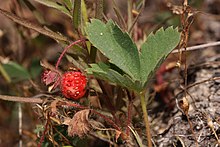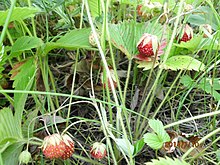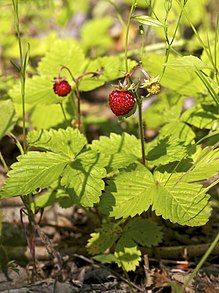Fragaria
![]()
Strawberry is a redirect to this article. For more information, see Strawberry (disambiguation).
Strawberries (Fragaria) are a genus in the subfamily Rosoideae within the rose family (Rosaceae). The genus Fragaria includes about twenty species, mostly found in the temperate zones of the northern hemisphere, and several subspecies; in addition, there are many hybrid forms with numerous cultivars.
Strawberries have played a role in human nutrition since at least the Stone Age. The European wild strawberries (Fragaria vesca) were also cultivated over a wide area during the Middle Ages. It was not until the 17th and 18th centuries respectively that the two large-fruited (and octoploid) American species - the scarlet strawberry (Fragaria virginiana) and the chile strawberry (Fragaria chiloensis) - arrived in Europe. The original form of the horticultural strawberry (Fragaria × ananassa), from which most of the varieties cultivated today are descended, arose from their crossbreeding in Brittany around 1750.
From a botanical point of view, the pseudo-fruit of a strawberry does not belong to the berries, but to the aggregate fruits or aggregate nut fruits or, according to another view, to the aggregate achenes (Achenecetum).
.jpg)
Flowering strawberry plant

View of the collective fruit
Description
Strawberries are perennial herbaceous plants. They are usually soft or silky-haired, with a thick, weakly woody "rootstock" that sprouts thread-like stolons. The stolons take root and form new rosettes (called blastochory). The alternate, basal, long-stalked stem leaves are usually three-fingered, rarely five-fingered. The stipules are attached to the base of the petiole.
Strawberries bear white, rarely yellowish flowers that appear after the end of the cold period. They are usually several in umbels at the top of the erect, arm-leaved stem. The flower cup bears five green sepals and five rounded corollas. Between the sepals proper are five more, smaller stipules (epicalyx). There are many stamens. Numerous free carpels sit on the convex receptacle. When ripe, the receptacle forms a juicy, fleshy false berry.
The fruits in the biological sense are small yellowish to reddish, one-seeded nutlets (according to another view achenes) on the surface of the red pseudo-fruit. The ovaries form one nutlet each, which are moved apart by the growth of the later striking red flower axis during the ripening period. Animals that eat the conspicuous strawberry fruit excrete the small hard-shelled nutlets that are found on the flesh of the fruit, so that the nutlets - provided they find suitable site conditions - can germinate (so-called endochory). In Europe, mammals such as red foxes, badgers, hedgehogs, bank voles and dormice; birds such as blackbirds, redstarts, robins, blackcaps and invertebrates such as Roman snails, some beetle species and millipedes are attracted to the fruits. They are thus involved in their dispersal. Ants even drag the fruit into their burrows, feed the pulp to their larvae and then carry the remaining nutlets away again. Strawberries, however, do not only use endochory and blastochory as dispersal mechanisms. Fruits that remain on the stems dry out after some time, with the nutlets falling off. This mechanism is called barochory.

Germinating seeds of a strawberry

The false berry ("strawberry") with the clearly visible nutlets is particularly large in the case of the garden strawberry (Fragaria × ananassa)
Types
The genus Fragaria includes more than 20 species and their hybrids. In all strawberry plants, the single chromosome set is composed of seven chromosomes, but there are differences in the degree of polyploidy. Thus, species and hybrids with double (diploid), quadruple (tetraploid), sixfold (hexaploid), eightfold (octoploid) and tenfold (decaploid) chromosome set occur, but also hybrids with an odd number of chromosomes such as 35 in a fivefold set (pentaploid).
diploid
- Fragaria bucharica Losinsk. , Western Himalaya
- Fragaria chinensis Losinsk. , China
- Fragaria daltoniana J. Gay, Himalaya
- Fragaria iinumae Makino, Japan and Far East Russia
- Fragaria mandschurica Staudt, North China
- Fragaria nilgerrensis Schltdl. ex J. Gay, Southeast Asia
- Fragaria nipponica Makino, Honshu and Yakushima (Japan)
- Fragaria nubicola (Hook. f.) Lindl. ex Lacaita, Himalaya
- Fragaria pentaphylla Losinsk. , North China
- Fragaria vesca L. or wild strawberry, Europe, North Asia and North America
- Fragaria viridis (Duchesne) Weston or cracked strawberry, Europe and Central Asia
- Fragaria yezoensis Hara, see F. nipponica ssp. nipponica
- Fragaria × bifera Duchesne, (F. vesca × viridis) hybrid, Europe
tetraploid
- Fragaria corymbosa Losinsk. , Far East Russia, China
- Fragaria gracilis Losinsk. , Northwest China
- Fragaria moupinensis (Franch.) Cardot, North China
- Fragaria orientalis Losinsk. , Far East Russia
- Fragaria tibetica Staudt & Dickoné, China
pentaploid
- Fragaria × bringhurstii Staudt, California Pacific Coast
hexaploid
- Fragaria moschata (Duchesne) Weston or musk strawberry, Europe
octoploid
- Fragaria virginiana Mill. or scarlet strawberry, North America
- Fragaria chiloensis (L.) Duchesne or Chile strawberry, North and South American Pacific coast and Hawaii
- Fragaria × ananassa subspecies cuneifolia, (F. chiloensis × virginiana) hybrid, North America
- Fragaria × ananassa (Duchesne) Decne. & Naudin or garden strawberry, hybrid of scarlet and chile strawberry, cultivated worldwide.
decaploid
- Fragaria iturupensis Staudt, on the Kuril Island Iturup
- Fragaria virginiana subspecies platypetala Mill. , Oregon (North America)
- Fragaria × vescana Rud. Bauer & A. Bauer, hybrid of garden and wild strawberry
The strawberry genus does not include some similar-looking and closely related species of cinquefoil such as the mock strawberry (Potentilla indica) and the strawberry cinquefoil (Potentilla sterilis). The strawberry trees, so called because of their fruits, on the other hand, belong to the heather family.

Scarlet strawberry (Fragaria virginiana ssp. platypetala)
.jpg)
Chilean strawberry (Fragaria chiloensis)
_(Great_Smoky_Mountains,_Tennessee,_USA)_1_(36641037730).jpg)
Scarlet strawberry (Fragaria virginiana)

Cracked strawberry (Fragaria viridis)

Wild strawberry (Fragaria vesca)
Search within the encyclopedia